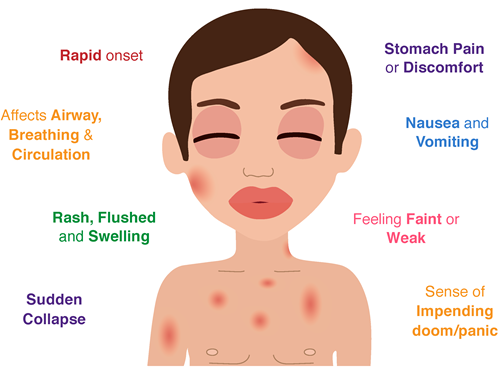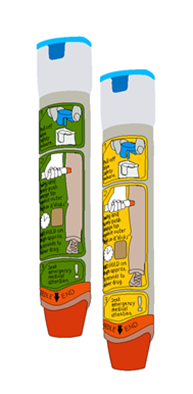24 May
by
Charlie Adams, Digital Marketing Executive
·
According to statistics from www.allergyuk.org, 21 million people in the United Kingdom have a food allergy and this number is increasing daily. Around 7 million have an allergy severe enough to require specialist treatment, and the UK has one of the highest incidences of allergy in the world.
Allergy signs and symptoms need to be recognised early to ensure that the right treatment is given. Signs of an allergic reaction usually occur within minutes of being exposed to an allergen but can appear up to two hours after exposure. Mild to moderate allergic symptoms can be treated with antihistamine medication but should be considered as possible 'early warning signs' as mild symptoms can quickly develop into a life-threatening severe allergic reaction.
|
What can trigger an anaphylactic reaction?
Some of the most common causes of anaphylactic reactions include:
- Foods such as peanuts, shellfish, milk, eggs, wheat and soy
- Venom from bites and stings
- Medications
- Other (latex, exercise or not identifiable causes)
|
 |
|
What are the symptoms of anaphylaxis?
An anaphylaxis emergency can occur within minutes to two hours of exposure to an allergen. Look for any of the following symptoms during an allergic reaction:
- Swelling of tongue, throat and/or mouth
- Difficulty in swallowing or speaking
- Flushing of the skin
- Nettle rash or hives anywhere on the body
- Severe asthma
- Abdominal pain, nausea and vomiting
- Difficult or noisy breathing
- A sudden feeling of weakness or dizziness (from a drop in blood pressure)
- Collapse or loss of consciousness
|
 |
|
Adrenaline
Adrenaline is an emergency medicine used to treat a severe allergic reaction. It works quickly to reverse the symptoms of anaphylaxis by reducing swelling, opening up the airway and improving blood pressure. Antihistamines should never be taken instead of adrenaline in the case of a severe allergic reaction. If asthma and symptoms of a severe allergic reaction occur at the same time then adrenaline should always be given first and the asthma relief inhaler afterwards.
Adrenaline auto-injector (AAI) devices contain the medicine adrenaline which is administered by an injection into the muscle in the middle of the outer thigh (upper leg). AAIs are prescribed by a doctor for those at risk of a severe allergic reaction based on an individual’s needs. They are designed to be user-friendly and to be used by anyone. It is important to know how to use the type of AAI you have been prescribed.
Action
- If the person having a severe allergic reaction has an adrenaline auto-injector (eg Epi-Pen) this should be used without delay.
- Always call an ambulance – dial 999 – say ANAPHYLAXIS – to get medical help as soon as possible
- Position is important -lie the person flat (if they are having breathing difficulties) they may prefer to sit up. Standing or moving (unless in an unsafe place) should be avoided.
- • Stay with the person having the allergic reaction until medical help arrives.
- If there is no improvement after five minutes and another adrenaline auto-injector is available, a second dose of adrenaline can be given ideally in the other leg.
• If a person has an allergic reaction that requires adrenaline, they should always go to hospital for further observation and treatment e.g. additional doses of adrenaline. Sometimes anaphylaxis can reoccur after the first episode has been treated and apparently settled.
|
  |
|
|
|
Quick thinking, fast actions and immediate treatment could save someone’s life.
Learn how to be prepared and properly treat an anaphylactic emergency by booking onto one of our courses.



